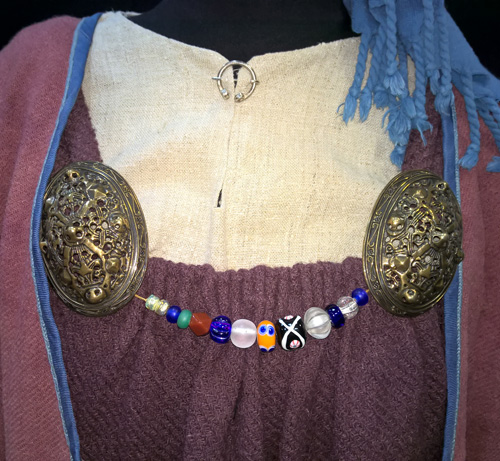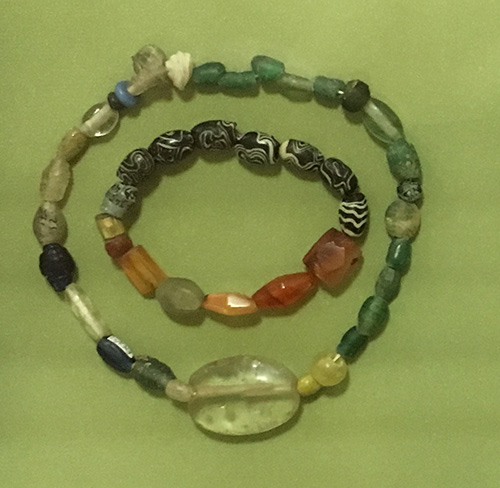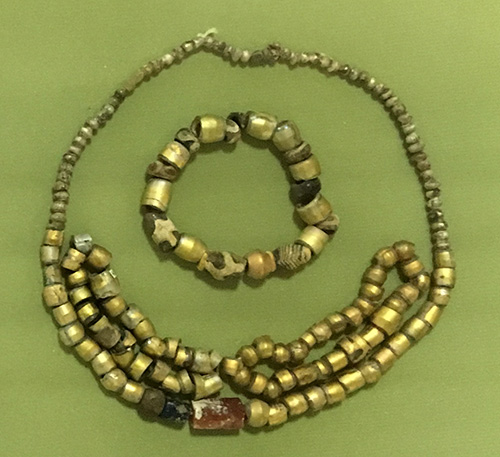 The Viking women adored necklaces. A 10th-century Arab once said that the Vikings would “go to any length to get hold of colored beads” (Wernick, 94). So, colorful glass-beaded necklaces, stone necklaces, gold and silver beads were extremely popular in Scandinavia. Also, remember that Viking women wore traditional suspended dresses called “hangerock” with an obligatory row of beads at the chest – they hang different small useful items there, such as needles, scissors, keys, a whetstone, etc. So, beaded necklaces were deeply incorporated into the Scandinavian culture.
The Viking women adored necklaces. A 10th-century Arab once said that the Vikings would “go to any length to get hold of colored beads” (Wernick, 94). So, colorful glass-beaded necklaces, stone necklaces, gold and silver beads were extremely popular in Scandinavia. Also, remember that Viking women wore traditional suspended dresses called “hangerock” with an obligatory row of beads at the chest – they hang different small useful items there, such as needles, scissors, keys, a whetstone, etc. So, beaded necklaces were deeply incorporated into the Scandinavian culture.
Beads were among the most favored Viking jewelry pieces. They could be made from glass, semi-precious stones, pearls, metal (gold, silver, bronze), etc. A lot of beads in the Middle Ages were imported from India, Middle East, Syria, and other far-away places for that time. So, of course, they were expensive and were highly valued. Women passed their necklaces to younger relatives – daughters, nieces, sisters, daughters-in-law, and so on. During the Viking raids, they always took beads among other treasures. And the beads trade was great in Scandinavia and many other countries, too.
Interesting fact! Beads are among the most often found items in the Viking burials. It means that they were valued very much to put them in the grave with their owner. They are almost as popular as knives and pottery found in burial tombs.
Scandinavian necklaces usually consist of a mix of glass and stone beads. It was a totally normal thing in the medieval period to wear necklaces with various mismatched beads. As they were rather hard to make and cost a lot, people often bought just a single bead at a time, so it took some time to gather enough beads for a necklace.

Modern reconstruction of medieval hangerock with typical jewelry. The necklace consists of mismatched glass and stone beads. The 10th century
In general, there were 3 main types of necklaces worn in Scandinavia: consisting of a number of identical beads (the same color, size, shape, produced in the same craft shop), a row of mismatched beads (from different artisans, made in different color, size, shape, and even from different periods of time – sometimes, dozens of years in between), and consisting of several groups of beads (for example, a few ornate glass beads of one type, a few stone beads, and a few smaller and simpler beads). Of course, when we’re talking about a matching row of beads, such a necklace was practically always created by the craftsman or merchant. And a row of mismatched beads could be made by a person who owned the necklace, or her ancestor, or a merchant as well.
Older Viking necklaces (from about the 9th century) usually consisted of a larger number of beads (over 16 items in one necklace), which were combined “recklessly”, without a system. Necklaces from the 10th-11th century were typically shorter, consisted of fewer beads, and the combination was more thoroughly made. Often, in the center of a necklace, were the largest beads, and they became smaller and smaller closer to the ends because they weren’t as visible.

Vintage beaded necklaces made from stone and glass beads from around the 9th – early 13th century. Archaeological finds
If to talk about the color of beads, among the most widespread colors were yellow, clear white (crystal beads), and blue.
Stone beads and pendants added to a necklace could be amulets and could have a symbolic shape (of an animal, an axe, a hummer, a crescent, etc). Such amulets were used by both men and women, but females added them to a necklace, while males wore them as a single pendant on a rope or leather strap.
Glass beads were more common than stone beads. There were craft shops and artisans who specialized in producing handmade glass beads. Such beads could be made from glass blanks specifically made to later turn them into beads or from fragments of broken glassware (if you were able to reuse such a costly material as glass, great!).
But even more expensive and valuable beads were glass beads with gold and silver foil. It was an extremely labor-intensive process to produce them, with a large percentage of defects. The temperature had to be just right, the craftsman had to be very skillful and careful, and other technological details had to be preserved. But they looked wonderful, and it was worth all the effort.

Vintage beaded necklaces made from stone and glass beads from around the 9th – early 13th century. Archaeological finds


